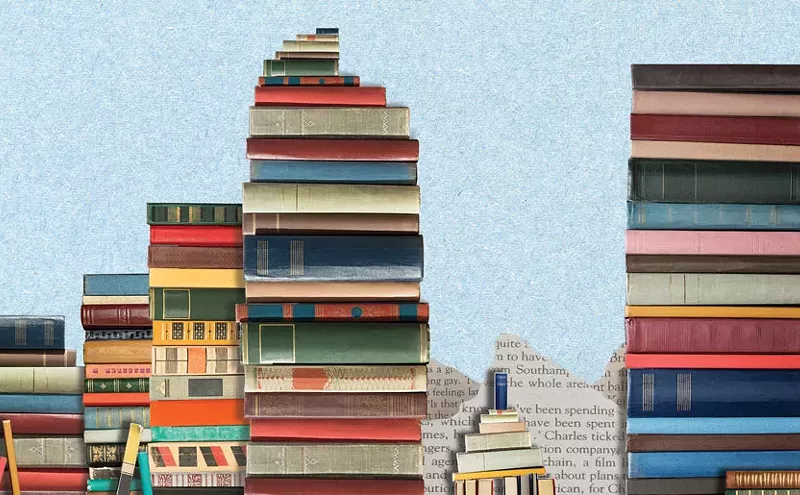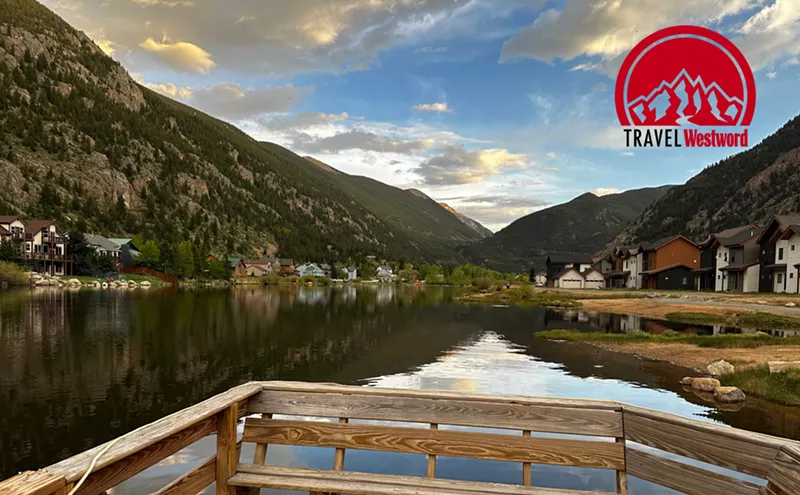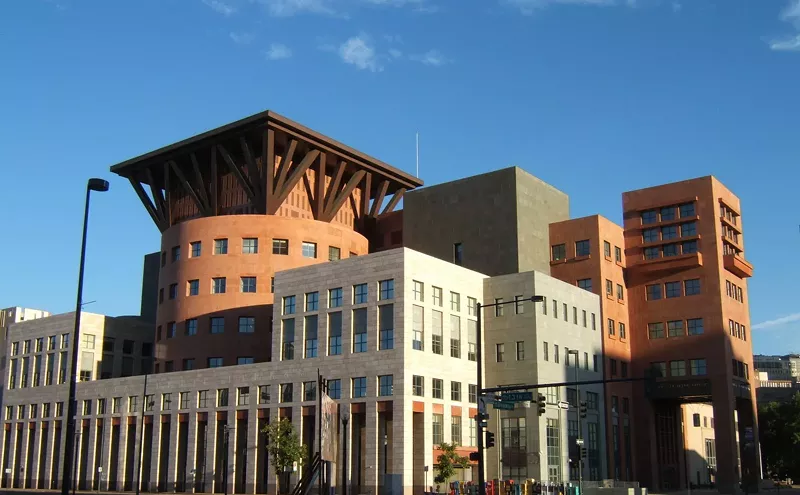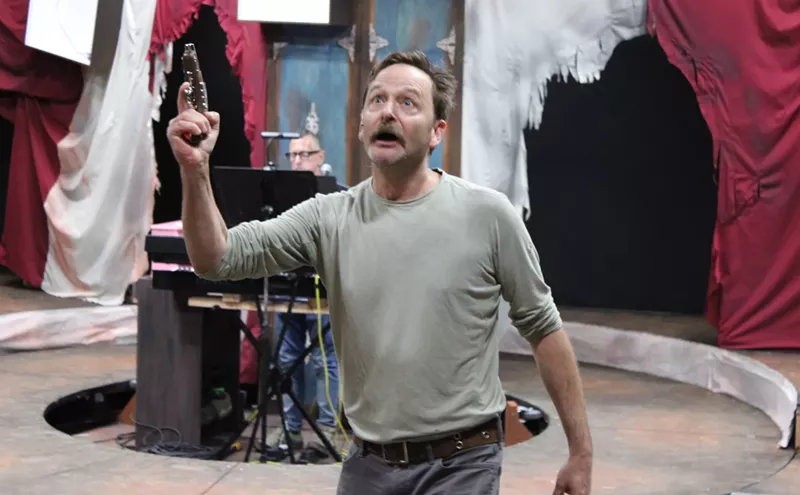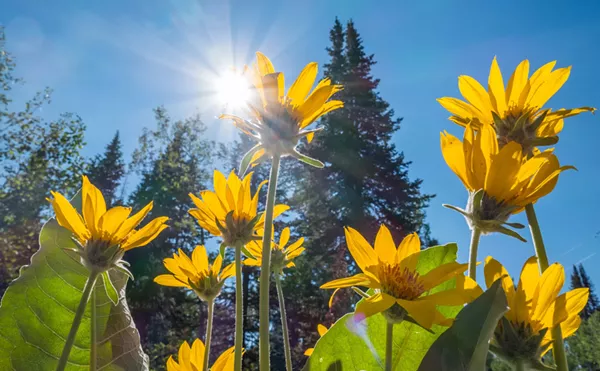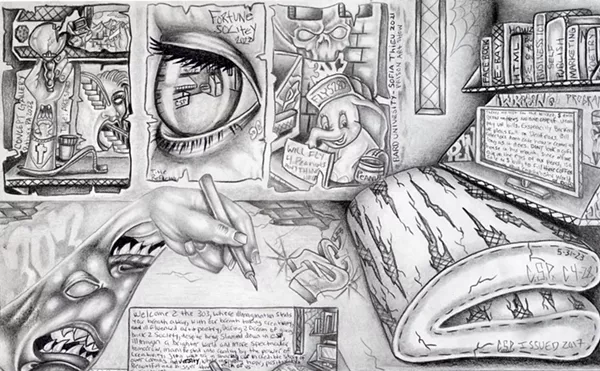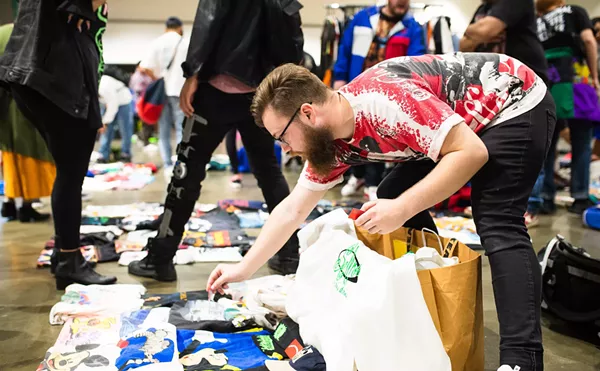I don't need to remind anyone what happened on September 11 in New York City, nor do I need to note that the art world, like the stock market, is headquartered there. Many of the most important galleries (and I'm talking about some of the most influential galleries on earth) are located just a few subway stops from the World Trade Center, in neighborhoods such as Tribeca, Chelsea and SoHo. Like the Financial District, those neighborhoods are in Lower Manhattan.
That means the prospects for this year's New York art season are pretty dismal, both psychologically and financially. It's unlikely that an art-auction record will be set; it's hard to imagine some new art-star kid suddenly becoming the toast of the Big Apple.
But here in Denver (a place that hasn't been considered much of an art-world asset before), far from New York, our geographic isolation may buffer us from the East's new austerity. And in any case, in the wake of the terrorist actions, several local gallery owners decided that the show -- or shows -- must go on.
Ricardo Mazal: Recent Paintings was scheduled to open September 14 at the Rule Gallery. "Ricardo lives in New York," says gallery director Robin Rule. "A lot of our artists live in New York, and a lot of them live in Lower Manhattan, and though Ricardo was in Santa Fe at the time, he was very upset. A lot of his friends lived within blocks of the World Trade Center. People don't realize there were a lot of artists down there. There were even artists with studios in the buildings."
As other organizations started canceling or postponing cultural events, Rule faced a difficult decision. "My first thought was to cancel," she recalls, "but I didn't know how I could do it, since the invitations had gone out a long time ago and the work had already gotten here, and Ricardo was driving up from Santa Fe. And if I did cancel, the whole schedule would be thrown off, so I just went on pure adrenaline and kept busy all week."
She was so busy putting up the show and setting up the preview that the opening reception is somewhat of a blur. "I don't even remember who was there or anything," Rule says.
The cocktail party might have been forgettable. Fortunately, Mazal's pieces are not.
Although he now resides in New York, Mazal was born in Mexico in 1950. Trained in the '70s at the University of Illinois as a graphic designer, he didn't turn to painting until he was in his mid-thirties, when he moved to Barcelona, an '80s art hotbed, and taught himself to paint. By the end of the decade, Mazal was exhibiting his abstract paintings in galleries in Europe and New York. Encouraged by his welcome reception from the New York art world, he moved there in 1991.
Rule's main gallery is devoted to a group of closely related Mazal abstracts. From one perspective, these paintings seem a complete departure for the artist; from another, they appear to be a clear continuation of the style displayed at Mazal shows at both Rule and the Singer Gallery over the past several years. Like those works, the newer paintings feature overall compositions organized through a network of lines. But where the earlier paintings were encrusted with thickly applied paint, these paintings are extremely flat, the pigments cut with solvents so that they stain the surface in the thinnest way possible. Mazal used ad hoc tools rather than brushes to create them, employing metal, plastic and cardboard trowels, some made specifically to achieve a particular desired effect.
Because the Mazal paintings are so monumental, Rule was able to construct a credible show using only five of them. It begins in the entry space with "One Inch Above #12," an oil-on-linen, wall-sized -- as opposed to easel-sized -- piece that presents all of the issues Mazal addresses in these works. Measuring more than than six by seven feet, this painting represents the smaller of the two sizes used in the "One Inch Above" series; the larger size, used for "One Inch Above #10," for example, is more than seven by eight feet.
For all of the paintings in the series, Mazal laid on a thin ground with broad swaths of color. The colors are subtle, predominated by bluish blacks and grays -- in some places purely blue -- as well as passages of umber, sepia and sienna. He then placed expressively drawn lines in the same colors on top of this ground. The arrangement of geometric shapes includes squares, rectangles and triangles; they sit on the surface of the picture plane as the ground recedes from the viewer, giving the painting a three-dimensional sense.
Pointing to the thin stains of the ground, Rule remarks that these paintings remind her of the color-field paintings Helen Frankenthaler did in the '50s and '60s. I see what she means, but I think these Mazal paintings are more reminiscent of abstract surrealism from the '40s and '50s, the kind of thing embraced by William Baziotes and Adolph Gottlieb. In fact, when I interviewed Mazal a few years ago, he mentioned Baziotes as an important source of inspiration.
The Mazal paintings are transcendental and beautiful -- which connects them to the latest craze in contemporary art, most recently displayed at the ongoing Site Santa Fe, organized by David Hickey. While Mazal was not included in Site proper, his work was on display in Santa Fe when Site opened this past summer. Will the new era that began abruptly on September 11 -- so different in so many ways from the one we were in before -- stop this growing interest in beauty right in its tracks? Will the national mood now demand message-oriented works that eschew beauty as a naive goal? Let's hope not: Beauty should never be obsolete.
At Carson-Masuoka Gallery, there was no thought of canceling FABstraction, since the show had opened on Labor Day weekend. But the gallery has certainly felt the effects of the horrible events of September 11. "At first, traffic fell off quite a bit," says Mark Masuoka, who owns the gallery with Sandy Carson. "But it's starting to pick up, and we're working on a lot of jobs we contracted for during the summer."
Given the art world's interconnections, a flat season in New York will be felt elsewhere, Masuoka notes. "We're setting up at a show in Chicago," he says. "We don't know what will happen. We're committed to it, so we can't back out now, but we're not sure how it's going to go. But it's our job and we have to do it. I think art gives people something that comforts them; we've had a number of people say that coming in and seeing the show made them feel better. It's what we can do in the art world: bring comfort to people."
Masuoka laughs when I ask whether the craze for beauty -- so amply displayed in FABstraction -- will start to wane. "Maybe people will need beautiful things more than ever," he says.
If they do, they couldn't come to a better place than Carson-Masuoka, because FABstraction is filled with beautiful objects. Organized by Masuoka, the show is very much like the Colorado Biennial he presented over a year ago when he was still director at Denver's Museum of Contemporary Art, both in its emphasis of beauty and in its attempt to survey a wide array of current contemporary-art approaches. "There's no ab-ex; everything is new," says Masuoka.
The show begins with a group of luscious paintings by Amy Sloan Kirchoff, a fairly recent arrival on the Denver art scene. For these pieces, beautiful jewel tones of red, blue, purple and yellow are set off by dusty pastels and neutral shades. In "Dance the Line, Blur the Rhythm," an acrylic on canvas, Kirchoff has painted loosely composed circles on top of one another, forming a dense composition. This use of circles, repeated in all of her paintings here, has a retro '60s quality, reflecting another current art craze. Despite the historic references, though, it gives the Kirchoff paintings a very contemporary feel.
Also very up-to-the-minute are two post-minimalist paintings in mixed media on paper laid on board by California artist Patsy Krebs. These stripe paintings simultaneously convey flatness and decidedly non-flat three-dimensional space -- a pair of attributes that would appear to be antithetical to each other, at least superficially, but are reconciled successfully by Krebs. Elaborate abstractions by Santa Fe's Kristy Rawson hang adjacent to Krebs's work, in the second space off the main part of the gallery. Rawson uses an intensely complicated process that includes acrylic painting, ink drawing, photocopy, acrylic transfer and applications of wax and oil to create these pieces. The resulting compositions, which form organic patterns, recall traditional fabrics -- another current contemporary painting trend, especially in the West.
That the West is developing its own contemporary ethos is seen even more clearly in Chad Colby's abstracts, which are based conceptually -- though not literally -- on landscapes. Like Kirchoff, Colby recently moved to Denver; he now teaches at Metro State. In his paintings, passages of color with hard edges define irregular shapes in pointedly non-decorative color schemes that often feature a lot of yellow.
Also Western in theme -- a relatively new trip for him -- are two spectacular, sophisticated installations by John McEnroe. One of the most insightful postmodernists working in Denver, McEnroe wants his wry observations about contemporary life to carry not just a conceptual punch, but a big visual one -- and these pieces hit the mark. "Blue Spruce" and "Red Oak" both use real logs, presumably spruce and oak, along with printed wood-grain plastic sheeting cleverly set side by side. Especially nice is the cobalt-blue-coated bough that leans against the wall in "Blue Spruce" and the ideologically similar use of a red-coated stump in "Red Oak." I've liked just about everything I've ever seen by McEnroe, who's exhibited in the area for over five years, but his work has never looked as good as it does right now in FABstraction.
Reflecting on both FABstraction and the Mazal show, I realized that Mark Masuoka was right. We do need beauty now more than ever.


